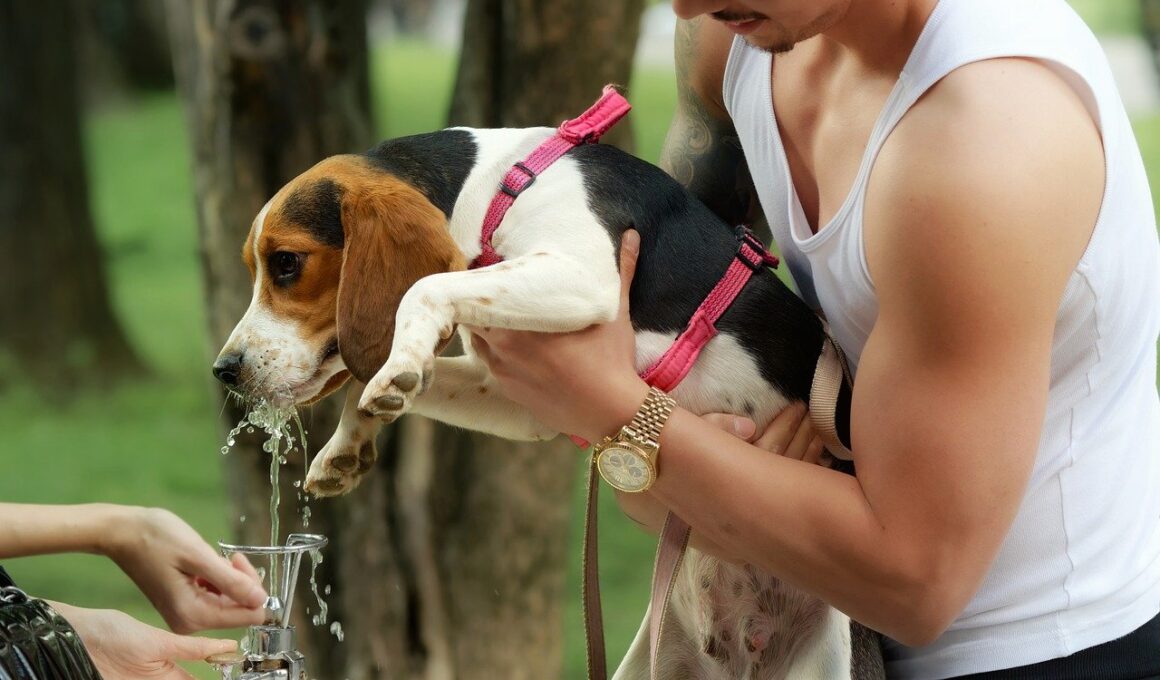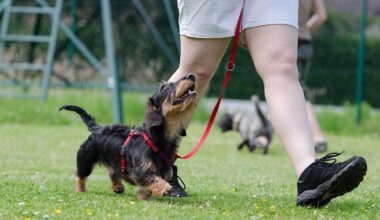How Weather Affects Hydration Needs of Senior Dogs
As temperatures rise during hot weather, the hydration needs of senior dogs become increasingly critical. Aging dogs may suffer from a reduced thirst drive, making it vital for owners to monitor their water intake meticulously. Additionally, the effects of heat can quickly escalate into severe complications such as dehydration, which poses significant risks. Dehydration can lead to serious health issues, including kidney failure and urinary tract infections. Regular access to clean and fresh water can alleviate these risks. Owners should also recognize the signs of dehydration, which include dry gums, sunken eyes, and lethargy. In hotter climates, it is advisable to encourage your senior dog to drink more frequently by providing water bowls in multiple locations around the home. You can also consider using ice cubes in the water for a fun twist that entices drinking. On hot days, limit strenuous activities and provide plenty of shaded areas for rest. Always consult with your veterinarian about any sudden changes in your dog’s hydration habits. Being proactive can help ensure a healthier life for your cherished pet, especially as they enter their golden years.
The Impact of Cold Weather on Senior Dogs
Cold weather presents its own challenges for senior dogs concerning hydration. Many owners might not realize that cold air can dry out a senior dog’s skin and mucous membranes, making hydration equally important. Moisture loss happens even in low temperatures, causing potential dehydration issues. It’s essential to ensure your senior dog is drinking adequately, even when they may not initially show signs of thirst. You can encourage them to drink by providing warm, fresh water and some healthy broth to stimulate their appetite. Additionally, consider offering wet foods that contain higher water content, as these can supplement their overall hydration needs. Checking their water bowl frequently is crucial since it can freeze during extremely cold weather. Inspecting the bowl will help ensure that they always have access to liquid. Keep a close eye out for signs of frostbite, which can occur if your dog spends too much time outside without proper protection. Remember to provide a warm, comfortable space for your senior dog indoors, particularly during the winter months. Maintaining proper hydration throughout the year is essential to your dog’s health, so stay vigilant.
Humidity levels can significantly alter the hydration needs of senior dogs, making it essential for pet owners to adapt their care accordingly. High humidity can hinder the natural evaporative cooling function of dogs, leading them to sweat less. Consequently, senior dogs may need even more water during high-humidity days to maintain hydration. However, they may not realize they need additional liquid, so proactive measures are essential. Owners can facilitate hydration by ensuring that fresh water is consistently available and by encouraging their dogs to drink regularly. If the humidity level is extremely high, it is advisable to adjust the dog’s exercise regimen by scheduling walks during the cooler times of the day. Consider incorporating shallow water play during hot summer days, as this can help cool them down and encourage drinking. Furthermore, monitoring your dog’s weight is essential, as significant weight loss may signify dehydration. It’s important to maintain a feeding schedule and offer hydrating treats. Exploring dog-safe fruits like watermelon can add variety and moisture to your dog’s diet, supporting overall hydration and providing essential vitamins.
Signs of Dehydration in Senior Dogs
Understanding the signs of dehydration in senior dogs is crucial. As they age, intuitive instincts may diminish, making it vital for owners to educate themselves. Key signs often indicate dehydration, such as dry, sticky gums or a loss of skin elasticity. If you gently pinch the skin and it doesn’t quickly return to its original position, this can indicate a hydration deficit. Additionally, observe your dog’s energy levels; fatigue or excessive lethargy could signal they are not getting enough fluids. Changes in urine output can also help determine hydration status; a decrease in urination frequency or overly concentrated urine signifies a need for more water. Furthermore, always check for specific behavior changes, such as seeking water more often or appearing restless. Regular vet check-ups will help assess your dog’s overall health and hydration needs. Keep your vet informed of any noticeable changes in behavior or health; this information clarifies your dog’s particular needs. Providing hydration solutions tailored for senior dogs can significantly affect their well-being and overall health. Keep their water bowls clean and accessible to ensure consistent hydration.
Warm weather often encourages outdoor activities, and while engaging your senior dog in play is valuable, it’s crucial to incorporate hydration solutions during and after these activities. Outdoor playtime can quickly lead to overheating, especially in older dogs who may struggle. Owners must ensure accessibility to water, particularly when engaging in prolonged exercise. An insulated water container can keep their water cool, encouraging your dog to drink instead of ignoring their thirst. Spread refreshing activities throughout the day, allowing plenty of downtime between outings. Wet towels can also be beneficial for cooling down a senior dog during outdoor play, exploring ways to stimulate hydration. Another effective method involves adding broth or flavoring to their water, making it exciting for them to hydrate willingly. Also, keep an eye out for your dog’s behavior during intense play; excessive panting and restlessness may indicate overheating and dehydration. Providing shaded areas for rest while outdoors is essential, ensuring they stay calm and comfortable. Making hydration a priority through thoughtful preparations allows your cherished pet to enjoy their time outdoors safely.
Best Hydration Solutions for Senior Dogs
Implementing effective hydration solutions tailored for senior dogs is essential to support their wellbeing. First, providing fresh water at all times will ensure proper hydration levels. However, senior dogs may need additional incentives to keep drinking. Incorporating wet dog food can significantly help meet their hydration needs, as it contains higher moisture content than dry kibble. Additionally, you can introduce irresistible treats containing water or broth to enhance their diet. Another option includes using pet water fountains, encouraging them to drink more due to the enticing freshness of running water. Consider also adding ice cubes or flavored water solutions to excite dogs about taking sufficient hydration. Ensure bowls are easily accessible and cleaned regularly to improve water quality. Always specify rural tap water or consider using filtered options if necessary. Some may prefer consulting with a veterinarian for hydration alternatives, particularly for senior dogs with special needs. Finally, devise a regular schedule for feeding and hydration, providing a daily routine that fosters water consumption. Your efforts will promote better health and quality of life, ultimately ensuring your dog enjoys their golden years to the fullest.
Monitoring your senior dog’s hydration is essential, requiring a comprehensive approach tailored to their changing needs. By remaining attentive to environmental conditions—be it hot, cold, or humid—we can significantly contribute to their wellbeing. Incorporating hydration solutions, such as fresh water supply, wet food, or even broth-enhanced treatments, provides an engaging way to meet their hydration needs. It’s crucial to observe signs of dehydration and intercept issues before they escalate. As pet owners, we should regularly consult our veterinarian to tailor hydration plans based on specific health considerations and individual requirements. Developing a routine that includes recognizing various environmental influences can help us encourage regular drinking habits. It is equally vital to monitor activity levels and alter schedules based on seasonal changes, ensuring their comfort. Additionally, using playful methods encourages dogs to drink more water, making hydration a fun interaction. Building a supportive environment allows for proactive hydration solutions—gracefully blending care and love for our aging companions. Through steadfast vigilance and proactive planning, we can extend the lives of our beloved senior dogs, making every moment in their golden years joyful and fulfilling.


